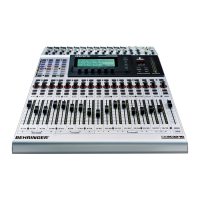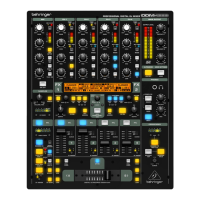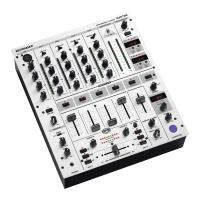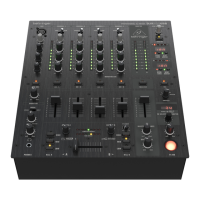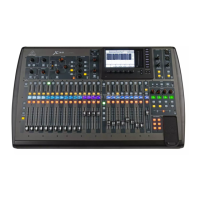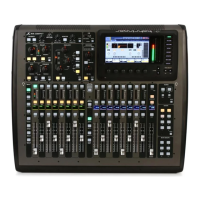24
5. EFFECTS PROCESSORS
A very special feature of your DDX3216 are the four built-in
multi-effects processors loaded with effect algorithms that were
specifically designed for the DDX3216. These four multi-effects
processors offer 26 different groups of first-class effects,
including such standard effects as reverb, chorus or delay, but
also unconventional effects such as a ring modulator, plus various
filter and lo-fi effects. Any parameter changes made on the four
effects processors can be recorded and played back as part of
a dynamic automation.
No. Effect Pr. 1 and 2 No. Effect Pr. 1 to 4
1 Cathedral 15 Delay
2 Plate 16 Flanger
3 Small Hall 17 Chorus
4Room 18Phaser
5 Concert 19 Tremolo
6 Stage 20 Autopan
7 Spring Reverb 21 Enhancer
8 Gated Reverb 22 Graphic EQ
9 Stereo Delay 23 LFO Filter
10 Echo 24 Auto Filter
11 Stereo Chorus 25 LoFi
12 Stereo Flanger 26 Ring Modulator
13 Stereo Phaser
14 Pitch Shifter
Tab. 5.1: Effect algorithms and effect processor
configurations
The first two multi-effects processors FX 1 & FX 2 allow you
to select any one of the effect algorithms available, while
processors FX 3 & FX 4 are limited to the effect algorithms
15-26.
To help you get to know the variety of effect algorithms
available, the DDX3216 comes loaded with 50 presets with
descriptive names, created by professional audio engineers.
5.1 FX menu
Use channel controllers FX 1-4 in the switch block to display
the various pages of the FX menu. To edit one of the four multi-
effects processors, you first need to select an algorithm for the
desired effects processor on the LIB page.
5.1.1 Selecting an effect algorithm
On the LIB page in the FX menu you can select one effect
algorithm for each of the four multi-effects processors.
Fig. 5.1: LIB page in the FX menu
Master controller 6 determines the effect processor (FX 1-4),
for which to select an effect algorithm or preset. Then, use
master controllers 3 & 4 to assign the various algorithms or
presets to the selected effects processor. Preset 1 (BYPASS)
disables the selected processor, while presets 2-27 contain
various effect algorithms and cannot be overwritten. Finally,
press master controller 2 (RECALL) to confirm the algorithm or
preset selected with SELECT PRESET.
When you edit a preset, the display below CURRENT PRESET
will change from “NOT EDITED” to “EDITED”. To store an edited
effect program, press master controller 1 (STORE), which
displays the STORE FX PRESET page, on which you can select
a memory location (28-128) and name your preset. Press ENTER
to store the preset, or CANCEL to return to the LIB page.
Memory locations 28-50 contain 22 effect presets created by
professional audio engineers, which can, however, be
overwritten to store your own settings.
+ Deleted factory effect presets (28-50) can be
restored only by loading a new operating system
software or by resetting the unit to its default
configuration (see chapter 16.2 “Loading factory
presets and automatic fader calibration”).
5.2 Editing effect algorithms
The selected effect algorithms can be edited on the
corresponding FX pages (FX 1-4).
5.2.1 Cathedral
This algorithm emulates the extremely dense and long reverb
of a cathedral and is ideal for solo instruments or vocals in slow
songs.
Fig. 5.2: Parameters of Cathedral algorithm
Decay (2 to 20 s)
The Decay parameter controls the duration of the reverb tail,
which is the time needed for the level of the reverb tail to drop to
-60 dB.
PreDelay (0 to 500 ms)
This parameter controls the delay (in ms), until early reflections
and reverb tail can be heard.
Damping (0 to 100%)
This parameter controls the attenuation of high frequencies in
the reverb tail. If used moderately, damping makes the reverb
sound more natural.
Density (0 to 50)
The Density parameter determines the density of the early
reflections.
Bass Multiply (-10 to +10)
Use this parameter to control the decay time in the low
frequency range of the reverb tail.
Diffusion (0 to 20)
The Diffusion parameter allows you to edit the density of the
reverb tail.
Reverb Modulation (1 to 10)
Reverb Modulation defines the modulation depth of the reverb
tail.
HiShv Cut (0 to 30 dB)
Use this parameter to determine the attenuation of the low-
pass filter wired to the input of the Cathedral algorithm.
5.2.2 Plate
The Plate algorithm emulates the sound of “ancient” reverb
plates, and is an ideal reverb for drums (snare) and vocals.
Fig. 5.3: Parameters of Plate algorithm
5. EFFECTS PROCESSORS

